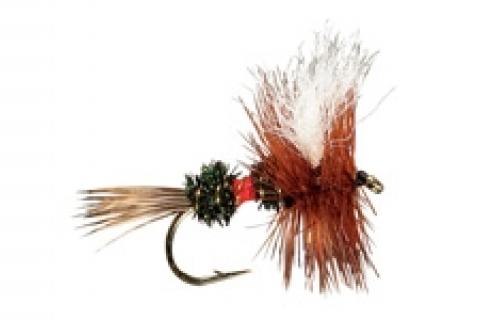
When going up against today's hard-pressured, discriminating trout it may seem like "attractor flies" that don't imitate a specific insect would be a poor choice.
 |
| The best trout attractor flies are high-floating and won't be pulled under by a frothy current or when floating through rapids. |
Well don't tell that to western trout anglers. I once wandered through Dan Bailey's legendary fly shop in West Yellowstone and counted no less than 14 variations of the famous Humpy. Like other attractors, these flies are "buggy-looking" creations that don't mimic a specific insect but look like "food" to trout and thus draw strikes.
They are particularly useful for boisterous western waters where trout don't have a long time to look at a fly and must grab it quickly or have it disappear downstream in the fast currents. But these flies can also be productive on many steep-gradient eastern streams in mountain settings. Quite often the trout there only have a second or two to grab a potential meal or watch it vanish, just like their western counterparts. And many of these eastern streams have fairly poor insect populations, so chances are the fish will nab it and worry later about whether it was an exact duplication of a specific species. Getting food in the stomach is the name of the game for these trout.
The best attractors are high-floating and will not be pulled under by a frothy current or when floating through rapids. Good patterns besides the Humpy include the Wulff Series, especially the Royal Wulff and the Stimulator, created by Randall Kauffman, founder of Kauffman's Streamborn. The latter is longer in form and vaguely simulates caddis and grasshoppers, but does not imitate any specific insect, Randall told me.
Another trait of attractors is that they are usually rugged flies that will hold up to catching several trout, sometimes dozens, before they fall apart. And since they are not precise duplications of a species, the more tattered and ragged looking they get, sometimes the more fish they'll catch. Even when they get a bit waterlogged and float part-way breaking through the surface film, these flies will catch trout-sometimes more than when they're bobbing on top of the water.
The only trouble then is they become a bit harder to keep track of on the water. If you see a strike where you think your fly is, simply pull back. If it was your fly the trout nabbed, you'll be solidly hooked up. If not, sometimes that jerking motion will entice a strike from a fish that thinks this "bug" has one last gasp in it and is trying to escape or take flight. Dabbing a drop of blaze orange paint to the top of these flies can also make them easier to detect when they start to get waterlogged but are still drawing strikes.
Top colors for Humpys are olive, yellow, gray and red. I like sizes 10-14 for western rivers, 14-18 for eastern streams with less flow and smaller fish. For particularly large and boisterous western waters also stock a few "double Humpys" with two flies tied on a single long-shank hook.
Cast them while wet-wading up tiny mountain creeks or from a drift boat gliding down the throat of a plunging western river. But whatever you do, don't overlook the potency of attractors such as Wulffs, Stimulators and Humpys.
They're productive, and they're fun to fish. What more could you ask?
- 2746 views

